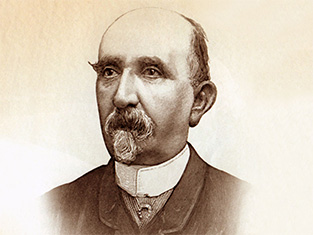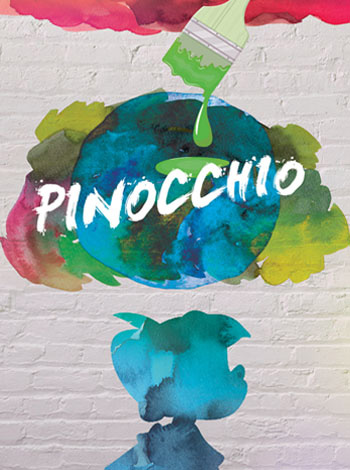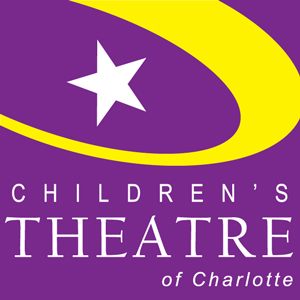Resource Guide - Pinocchio
Before the Show
Click on a topic to expand/hide content:
+ About the Show
+ What's a Ghost Light? Pinocchio opens with a bare stage, illuminated by a single light. This light is a theatre tradition, called a ghost light. The ghost light is a light that is left energized on the stage when the theatre is unoccupied and would otherwise be completely dark. The practical use of a ghost light is for safety, so someone can find the lighting controls while avoiding accidents such as falling into the orchestra pit or tripping over set pieces. Some claim that the tradition began in the days of gas-lit theatres when dim gas lights were left burning to relieve pressure on the gas valves. Aside from its obvious practical purpose, there are a number of theatre superstitions associated with the origin and purpose of ghost lights. Click here to learn more about the history and superstitions surrounding the ghost light.
Pinocchio opens with a bare stage, illuminated by a single light. This light is a theatre tradition, called a ghost light. The ghost light is a light that is left energized on the stage when the theatre is unoccupied and would otherwise be completely dark. The practical use of a ghost light is for safety, so someone can find the lighting controls while avoiding accidents such as falling into the orchestra pit or tripping over set pieces. Some claim that the tradition began in the days of gas-lit theatres when dim gas lights were left burning to relieve pressure on the gas valves. Aside from its obvious practical purpose, there are a number of theatre superstitions associated with the origin and purpose of ghost lights. Click here to learn more about the history and superstitions surrounding the ghost light.
+ The BIG Questions Before the Show
+ Vocabulary Enrichment
+ Activities
Make Your Own Finger Puppet
Use this printable worksheet to create your own finger puppet - then put on a show with your classmates!
Finger Puppet Worksheet
Vocabulary Word Scramble
Using the printed worksheet, can you unscramble the words related to the show?
Word Scramble Answer Key
+ Who created the story of Pinocchio? Italian author Carlo Collodi was born Carlo Lorenzini in 1826 in Florence, Italy. He started out as a journalist and created two different newspapers, one being specifically for children. His children’s magazine is where he started publishing the story of Pinocchio one chapter at a time. Collodi’s works present children as playful and sometimes mischievous which causes them to learn a lesson by the end of the story.
Italian author Carlo Collodi was born Carlo Lorenzini in 1826 in Florence, Italy. He started out as a journalist and created two different newspapers, one being specifically for children. His children’s magazine is where he started publishing the story of Pinocchio one chapter at a time. Collodi’s works present children as playful and sometimes mischievous which causes them to learn a lesson by the end of the story.
+ About the Show
High among the scaffolding, a group of painters begin the day’s work. Using the objects around them, they bring the story of Pinocchio to life in real-time, creative fashion. Kind-hearted Geppetto carves a little puppet from wood to call his own. But Pinocchio dreams of being a “real boy” and seeks adventure unaware of the danger it brings. When he learns his papa is in trouble, Pinocchio sets his selfishness aside learning that he doesn’t need to be real to be brave.
Themes: Honesty, Bravery, Loyalty
+ What's a Ghost Light?
 Pinocchio opens with a bare stage, illuminated by a single light. This light is a theatre tradition, called a ghost light. The ghost light is a light that is left energized on the stage when the theatre is unoccupied and would otherwise be completely dark. The practical use of a ghost light is for safety, so someone can find the lighting controls while avoiding accidents such as falling into the orchestra pit or tripping over set pieces. Some claim that the tradition began in the days of gas-lit theatres when dim gas lights were left burning to relieve pressure on the gas valves. Aside from its obvious practical purpose, there are a number of theatre superstitions associated with the origin and purpose of ghost lights. Click here to learn more about the history and superstitions surrounding the ghost light.
Pinocchio opens with a bare stage, illuminated by a single light. This light is a theatre tradition, called a ghost light. The ghost light is a light that is left energized on the stage when the theatre is unoccupied and would otherwise be completely dark. The practical use of a ghost light is for safety, so someone can find the lighting controls while avoiding accidents such as falling into the orchestra pit or tripping over set pieces. Some claim that the tradition began in the days of gas-lit theatres when dim gas lights were left burning to relieve pressure on the gas valves. Aside from its obvious practical purpose, there are a number of theatre superstitions associated with the origin and purpose of ghost lights. Click here to learn more about the history and superstitions surrounding the ghost light.+ The BIG Questions Before the Show
- Think of a time when you had the choice to lie or tell the truth. What did you do? How did you make your decision?
- What does bravery mean to you?
CCSS.ELA-Literacy.SL.(K-5).2:: Ask and answer questions about key details in a text read aloud or information presented orally or through other media.
+ Vocabulary Enrichment
Pick three words from the list and use them in an original sentence or paragraph. You can also draw a picture, illustrating the definitions.
- Frightened - afraid or anxious
- Ciao - Italian for both “hello” and “goodbye”
- Arrivederci - Italian for a formal “goodbye”
- Si - Italian for “yes”
- Tarantella - A lively Italian folk dance
- Shiver - so cold that you are shaking
- Cheeky - playful and rude
- Rascal - a mischievous person, usually a child
- Clever - quick to learn or understand ideas
- Dervish - To say someone is moving “like a dervish” means the person is moving or working quickly. This is derived from the energetic religious dancing of the whirling dervishes
- Tremendous - very impressive or very large
- Miserable - very unhappy
- Miracle - very surprising and unexpected
CCSS.ELA-Literacy.L.(K-5).4: Determine or clarify the meaning of unknown and multiple-meaning words and phrases.
+ Activities
Make Your Own Finger Puppet
Use this printable worksheet to create your own finger puppet - then put on a show with your classmates!
Finger Puppet Worksheet
NCES-VisualArts.1.V.3.3: Use the process of drawing, painting, weaving, printing, stitchery, collage, mixed media, sculpture, and ceramics to create art.
Vocabulary Word Scramble
Using the printed worksheet, can you unscramble the words related to the show?
Word Scramble Answer Key
+ Who created the story of Pinocchio?
 Italian author Carlo Collodi was born Carlo Lorenzini in 1826 in Florence, Italy. He started out as a journalist and created two different newspapers, one being specifically for children. His children’s magazine is where he started publishing the story of Pinocchio one chapter at a time. Collodi’s works present children as playful and sometimes mischievous which causes them to learn a lesson by the end of the story.
Italian author Carlo Collodi was born Carlo Lorenzini in 1826 in Florence, Italy. He started out as a journalist and created two different newspapers, one being specifically for children. His children’s magazine is where he started publishing the story of Pinocchio one chapter at a time. Collodi’s works present children as playful and sometimes mischievous which causes them to learn a lesson by the end of the story.After the Show
Click on a topic to expand/hide content:
+ The BIG Questions After the Show
+ Activities
Tableaux Time
As a class, review the events of the play. It may be helpful to write them down on the board for the whole class to see. After reviewing the play, divide your students into groups and assign each group a different part of the story. Their job is to create a tableaux, or frozen picture that retells their portion of the story. Remind them that a picture does not move or speak so their poses have to be very dramatic in order to tell the story. Have each group share their tableau for the class.
Acts of Bravery
Pinocchio doesn’t start out brave. He has to learn what it means to be brave. As a class, discuss what it means to be brave. Remind them that bravery isn’t always big actions like saving someone from being eaten by a whale. Encourage them to think of smaller acts of bravery that happen every day like inviting someone to eat with them or trying something new. Set a timer and give your students time to journal about a time they were brave.
+ Talk About Theatre Jobs
+ External Links
+ Recommended Reading
+ The BIG Questions After the Show
- What lesson do you think Pinocchio has learned by the end of the story?
- Some of the big themes in Pinocchio are bravery and loyalty. When does Pinocchio show he has become brave and loyal? When have you been brave or loyal?
CCSS.ELA-Literacy.SL.(K-5).2: Ask and answer questions about key details in a text read aloud or information presented orally or through other media. NCES-TheaArts.2.TA.A.1.2: Analyze the relationships between events, characters, and settings. NCES-TheaArts.4.TA.A.1.2: Critique choices made about characters, settings, and events as seen, or portrayed in, formal and informal productions.
+ Activities
Tableaux Time
As a class, review the events of the play. It may be helpful to write them down on the board for the whole class to see. After reviewing the play, divide your students into groups and assign each group a different part of the story. Their job is to create a tableaux, or frozen picture that retells their portion of the story. Remind them that a picture does not move or speak so their poses have to be very dramatic in order to tell the story. Have each group share their tableau for the class.
NCES-THEATRE ARTS.(3-5).TA.AC.2: Use performance to communicate ideas and feelings. CCSS.ELA-LITERACY.SL.4.2: Paraphrase portions of a text read aloud or information presented in diverse media and formats, including visually, quantitatively, and orally.
Acts of Bravery
Pinocchio doesn’t start out brave. He has to learn what it means to be brave. As a class, discuss what it means to be brave. Remind them that bravery isn’t always big actions like saving someone from being eaten by a whale. Encourage them to think of smaller acts of bravery that happen every day like inviting someone to eat with them or trying something new. Set a timer and give your students time to journal about a time they were brave.
CCSS.ELA-LITERACTY.W.1.1: Write opinion pieces in which they introduce the topic or name the book they are writing about, state an opinion, supply a reason for the opinion, and provide some sense of closure.
+ Talk About Theatre Jobs
Every play Children’s Theatre of Charlotte produces is created by a talented team of designers, technicians, actors, and a director. As a class, discuss what you experienced when you saw the performance.
- Name three things you noticed about the scenery. Did the scenery help tell the story? What sort of scenery would you design?
- What did you like about the costumes? Did the costumes help tell the story? What sort of costumes would you design?
- What role did lighting play in telling the story? How did the lights enhance what you were seeing?
- Talk about the actors. Were there moments you were so caught up in the story you forgot you were watching a play?
- Were there any actors who played more than one character? What are some ways you can show you are a different character?
NCES-TheaArts.(3-5).TA.A.1: Analyze literary texts and performances. NCES-TheaArts.(3-5).TA.AE.1.2: Understand how costumes [and technical elements] enhance dramatic play.
+ External Links
+ Recommended Reading
If you enjoyed the show, travel to ImaginOn or your local Charlotte Mecklenburg Library branch and check out these books. Check availability at cmlibrary.org.
- Peter Pan by J.M. Barrie
- The Tale of Despereaux: Being the Story of a Mouse, a Princess, Some Soup, and a Spool of Thread by Kate DiCamillo
- Charlie and the Chocolate Factory by Roald Dahl
- The Flying Bed by Nancy Willard

By Greg Banks | From the story by Carlo Collodi | Produced by special arrangement with Plays for New Audiences





